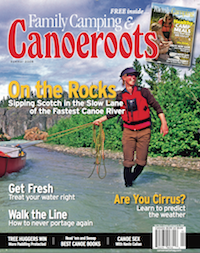Think of lining rapids as the great compromise. Lining lets you avoid a rapid that is too shallow or tight and technical to paddle, without having to shoulder your load and hit the trail. When lining properly, you use ropes and the force of the current to steer your canoe safely down sets.
Set Up
The ideal rigging requires two 20-metre throwbags and a bridle consisting of a three-metre length of rope with a loop tied at the halfway point. Using a bowline, tie one end of a throwrope to the loop in bridle, slide the bridle under the hull and tie each end off inside the gunwales at a thwart or seat. The loop should be near the keel line and at least a metre from the stern of the canoe.
With this bridle set-up you can control the canoe from below the waterline. Though lining a canoe with the stern line attached to a grab loop near the deck is possible (not to mention common) a strong pull on the grab loop from an angle can flip the canoe (many readers are nodding knowingly right now). The bow rope can be attached to the grab loop of the canoe since it will only be used to control the canoe angle.
If you don’t trust yourself to re-pack throwbags after each use then use a fixed painter on the bow. It should be of large diameter (so it is easy to grip) and both buoyant and free of knots (to reduce the chances of it getting jammed between rocks).
Safety
Whenever rope and currents mix you need to be prepared. Both paddlers should have a knife handy in case the rope gets tangled. Leave any excess rope in the bag or in loose coils in your hand. You should be wearing a PFD and if you trip with a helmet there is no sense having it in the canoe and not on your head while you scramble over wet rocks.
Starting Line
Push the canoe out into the current and let it float downstream until the stern rope becomes taut. Try not to let all the rope out. By pulling on the downstream rope while the upstream rope is taut, you will set an angle just as you would in a back ferry and the boat will ferry away from shore. To move the boat toward shore release the downstream rope and pull in on the upstream rope. The canoe’s angle will change and the current will push the canoe toward you.
By keeping pressure on the downstream end you can have the canoe ferrying as much as 45 degrees out into the current below you.
Adjust the angle until the canoe is lined up, then slowly walk downstream while keeping the ropes taut to control the angle and the canoe’s position.
Too many people risk broken ankles and capsized canoes by relying on luck and quick feet when lining. With this under-the-hull bridle set-up, lining can be less about speed and recovery and more about control and finesse.
Mark Scriver is a Black Feather guide and the author of Canoe Camping, An Essential Guide.




